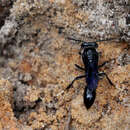en
names in breadcrumbs



Trypoxylon is a genus of wasps in the family Crabronidae. All Trypoxylon species that have been studied so far are active hunters of spiders, which they paralyse with a venomous sting, to provide as food to their developing larvae.[1][2] Depending on the species, they will either construct their own nest from mud or find cavities that already exist.[3] These cavities can range from keyholes to nail holes to previously abandoned nests, and are generally sealed with mud to create cells for their larvae.
The 634 species in this most speciose genus are found worldwide being represented in the Palearctic, Nearctic, Afrotropic (largest number of species in the Old World), Neotropic (highest number of species), Australasia (poorly represented) and Indomalayan realm. [4]
 Trypoxylon collinum pupa
Trypoxylon collinum pupa  Trypoxylon collinum adult
Trypoxylon collinum adult Trypoxylon is a genus of wasps in the family Crabronidae. All Trypoxylon species that have been studied so far are active hunters of spiders, which they paralyse with a venomous sting, to provide as food to their developing larvae. Depending on the species, they will either construct their own nest from mud or find cavities that already exist. These cavities can range from keyholes to nail holes to previously abandoned nests, and are generally sealed with mud to create cells for their larvae.